#shinboku
Explore tagged Tumblr posts
Text

— [ X ] ⛩️
#digital art#artists on tumblr#fantasy#oc#ocs#original character#original characters#origianl art#original comic#comic#webcomic#wolf#wolves#fox#raccoon dog#yokai#japanese yokai#yokai oc#kitsune#tanuki#yuki onna#supernatural#werewolf#werewolves#lycan#lycanthrope#lycanroc#torii#torii gate#shinboku
82 notes
·
View notes
Text
Ok so in past week or whatever.
I got caught with Furitsumore Kodokuna Shi Yo (puts title into jisho so i accidentally know how to pronounce it.) Coincidentally the day I got caught up was the release of new ch, which for now is behind paywall and idk if other sites have reuploaded it yet. So technically im one ch behind but who cares. The last couple chs have been flashbacks of the events in the village/the things described in Haikawa’s journal that Kanon just found. so like pace of the story has kinda slowed down for a bit. but jesus the events b4, with the death of sosuke and saeki resigning from the force to continue his vigilante justice. hoooly shit. i was thinking abt it like the rest of the day. im guessing this will mark the big turning point with this series, like how the focus of shinboku significantly shifted with the death of Eiji’s alter/his arrest.
Also I finished The Mitarai’s House is on Fire, woohoo. I site I was reading on did not have jpv7 for whatever reason, so I used one of the itunes gift cards I got over the holidays to buy it on mangabang. and no regrets here because I ended up loving the series alot. (also v7 has the AnzuxKichi confession and kiss scene which makes me insane and of course I bookmarked that shit……)
MitaraiKe just has like so much stuff to digest/so many diff perspectives you can analyze it from. it was such a delicious text imo. and also made me feel many emotions. im glad I finally decided to read it and I hope the la drama premiering next month (i think) is able to capture the series’ magic…..
#hoping to write latger post on both of these but also aaaa still havent done one for shinboku/#may just condense the shinboku one into my suffocating lonely death post or something idk/#wish i had motivation to write ☹️ instead of just daydream
0 notes
Text
ISAT OCS: concept art dump and notes
Part 0 | Introductions | Concept Art Dump | Ornithomancy | Memes
-
i present to you: the archive of isat oc doodles, pieces, and various other visual media that i have amassed over the course of 6 months!
-
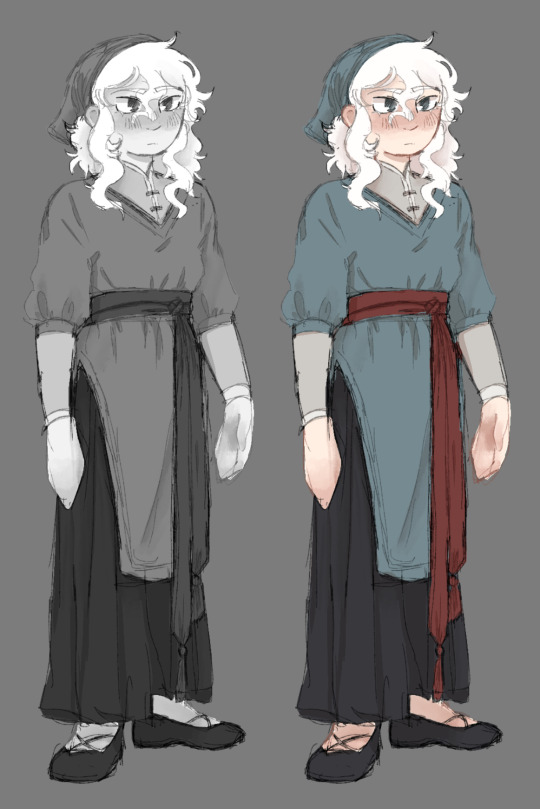
messy celest ref! fun note: she knows how to do traditional weaving techniques. her belt in my mind is a tablet weave, but i couldn't exactly get the texture right on scale. also don't look at the hands! i got tired!
-
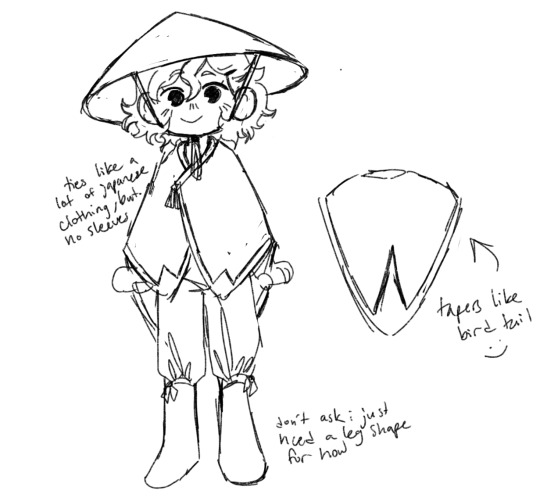
haruka concept and the final design! she went though a couple of iterations, but this the one we settled on. you can see the clothes she's wearing under in her sprite comp as well.
-
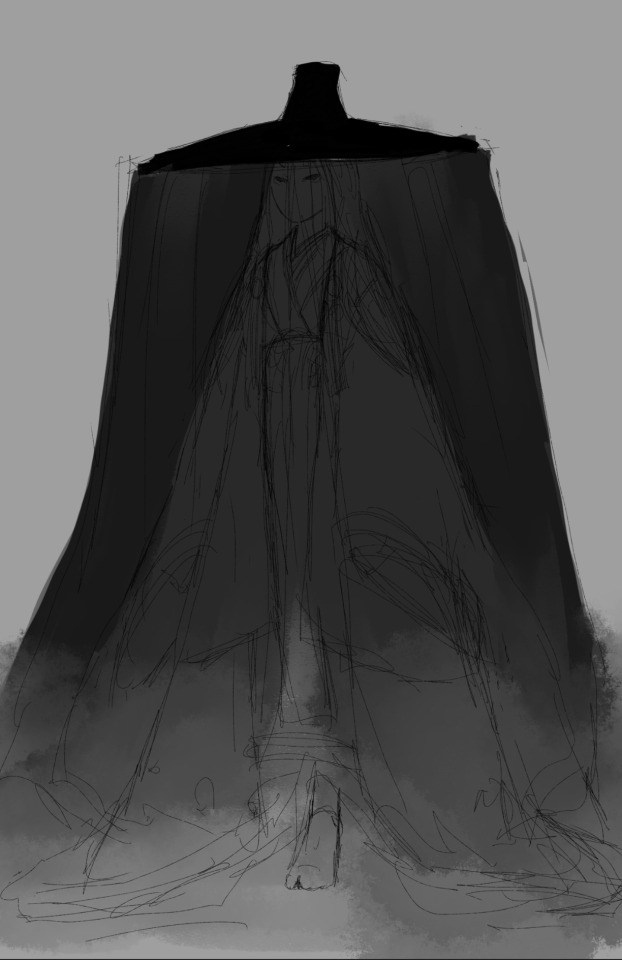
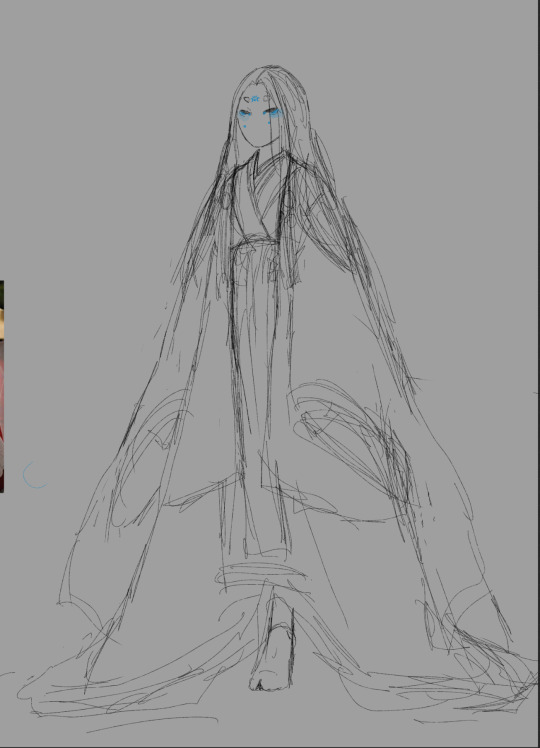

Aega concepts! she is a Giant Woman; she stands at her 7'8''. her body is actually a porcelain ball jointed doll, made before the island nuke to use as a vessel for her within her shrine. her weapon was originally inspired by the bloodborne trick weapons, and could turn from the naginata to a scythe, but that ended up being scrapped because the design was kinda janky. also, she is heavily inspired by the twin sisters from Kubo and the two strings.
-
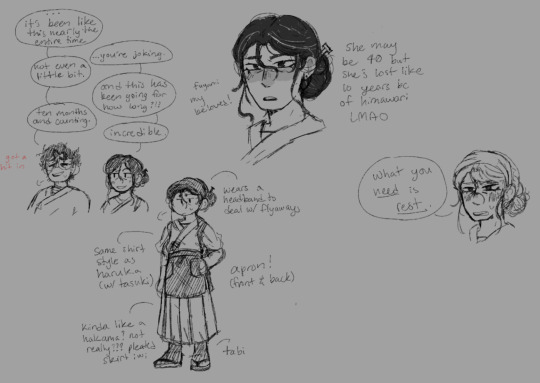
fuyumi concept art! she's haruka's mom– she doesn't show up until postcanon, but she's genuinely one of my favorite characters and her energy is delightful. she's a rock type but specializes as a rather formidable healer.
-
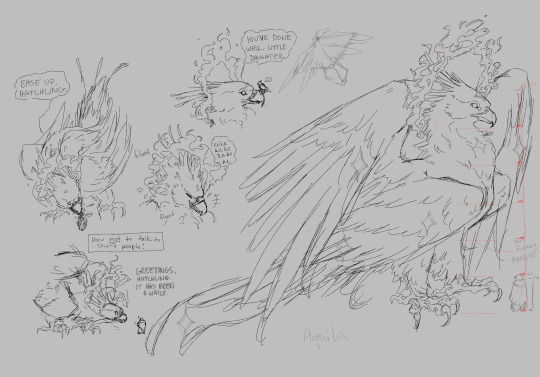
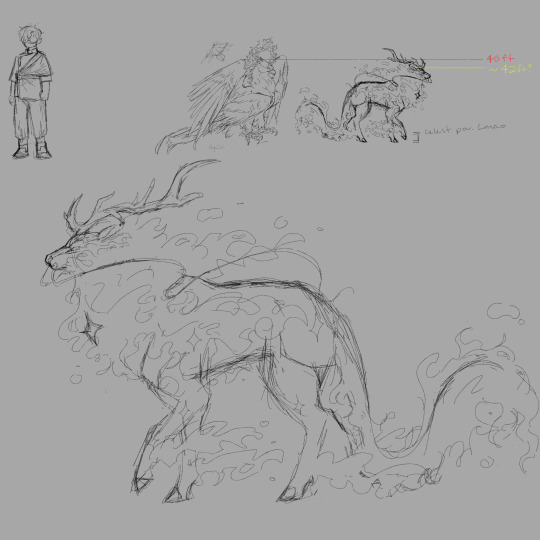

other expressions concept art! there are actually 4 in total; aquila (the eagle), monoceros (the qilin), ophiuchus (the turtle and snake), and draco (who is. obviously. a dragon. but i haven't designed him yet). they're heavily inspired by the four holy beasts from a piece of chinese classical literature. typically, the white tiger takes the place of the qilin, but some versions swap the two. these are essentially the divine beasts from breath of the wild, and they each have their own questline, associated party member, and dungeon accordingly. Himawari is connected to Aquila (DEEPLY and extremely lore relevant fact); Haruka to Ophiuchus (inspired by Asclepius, the greek god of medicine); Celest to Monoceros (the qilin is often compared to a unicorn in the west, though they're pretty distinct); and Ori with Draco (even though he's not pictured here, he's a traditional east asian dragon design and carries a massive pearl).
-

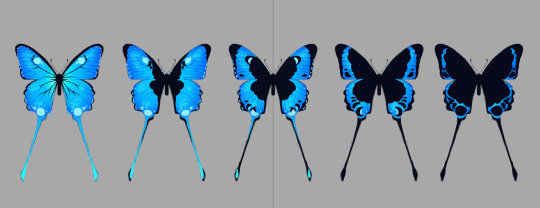
original fauna i made for worldbuilding and drawing practice.
the eagle is an Okibi Eagle, whose design is a pretty solid mix between a harpy eagle, the golden eagle, white-tailed eagle, and secretary bird. lore-wise, they were used as falconry birds by a few clans, but disappeared after the Island got nuked. Himawari's design is heavily inspired by them (well, vice-versa, but you get the picture).
the butterflies are actually an enemy; they're called Moonflies, and they're part of the stuff that happens once Aega's influence spreads. Their wing scales shed constantly, and when they're breathed in, they cause a potent anesthetic and hallucinogenic effect similar to what Aega's sleep does. They swarm together and, mechanic-wise, perform a similar service to what the Kings Tears do during his fight. Their coloration changes depending on the lunar phase they emerged during. Their design was a mix of the Aega morpho, japanese luna moth, lyretailed phoenix swallowtail, emerald swallowtail, and blue peacock swallowtail.
-
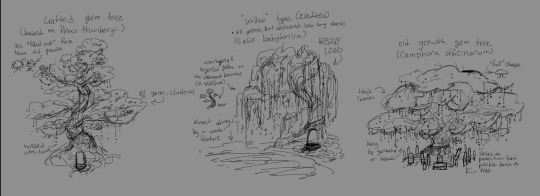
gem trees! they're a ka buan adaptation of favor trees; in the lore we've stated that the favor tree concept itself was an Islander tradition that has been so morphed into common life that most places where the Islanders had some impact has some variation of them. the design and function are extremely similar to shinto traditions of marking sacred trees inhabiting kami with shimenawa, as well as shinboku, trees where tags asking for blessings are left for a shrine's kami to fulfill. instead of tags, carved gemstones are used and hung from the branches of trees. some are natural, old-growth trees like camphor trees, but sometimes there are trees constructed with wire to act as a more stable and malleable version.
-
(himawari and aega belong to @dasnercaret; orion belongs to @scramblecat; haruka and fuyumi belong to @aquakirb)
-
Part 0 | Introductions | Concept Art Dump | Ornithomancy | Memes
#isat#in stars and time#wormwood rambles#isat ocs#isat spoilers#kinda?#illustration#isat fanart#concept art#worldbuilding#oh wormwood
52 notes
·
View notes
Text
"In the story of the mind, there is four at play."
"The pied piper leads one with desires and temptations. On earth he stands with man, no different from them. All who are blinded follows him downwards for he is the Fool."
"The baba yaga observes one with insecurities and weariness. On earth they stand apart from man, connected to the sea. All who are deaf, will not follow them ahead for they are the Witch."
"The shinboku guards one with fears and panic. On earth she stand away from man, as she is the flora. All who are gormless, will be dragged back by her for she is the Mother."
"The devil consumes one with hatred and malice. On earth it stands nowhere, as it is scourge of man. All who are astray, will be killed by it, for it is the Thief."
"In a ring on the palm, they dance and sing to the music from above, so as below"
"What is the rythm they dance to?"
//how I felt writing all this (idk if I actually cooked 😭
#idk where to put thos#may or may noy be lore related#Think no; Hear no; See no Evil. Hear no; Do no; No; Do the Evil. /lyr#block tales#greed block tales#solitude block tales#fear block tales#hatred block tales#writing#block tales parody#as above so below#also not me cooking from 6 to 8 am lol
20 notes
·
View notes
Text
Akasaka Hikawa Shrine
This is the shrine that was the inspiration for the 90s anime for Rei's family shrine.
Pictures were taken on December 3, 2022.

Path leading up to the shrine. You can see the long staircase in the distance.

Tooroo, stone lantern.

Hmmm. Just gave me a few story ideas but I'm not sure where this bridge would go in the 90s anime version.

Inari statues and mini shrine.

This is how it looks in the anime.

The main shrine building is a lot further back and can't be seen.

Went up the stairs and paused for a picture.

Pausing in front of the torii gate for the main entrance. Super excited at this point since after the shrine was the Sailor Moon Museum and all of Juban.

Torii gate with Tooroo (stone lanterns)

Komainu (lion dogs) are near the toorii (gate) to the entrance.

This one is un-gyoo since the mouth is closed.

The one with the mouth open is a-gyo. They are guardians of the shrine and are always seen in pairs. They are meant to represent the beginning and end of things.

One more view of the komainu from the anime. Next time I'll have to stand here and turn around to see if any of Tokyo is visible.

Shinboku, sacred tree. The closest I could find from the anime but still really different.

Rei is tying Omikuji to a tree. Ones that are bad luck are left behind at the shrine so the mikos can pray they become good luck. I did purchased one here for good luck. But this post is already long enough and will be feature in the next one.

Found Omikuji here. Same tree from above is in the background.

Emma, wooden block prayers.

Mikoshi used for festivals.

Found a miko in one of the buildings in the distance.

Another small shrine. I'm not sure who this represents.

Same type of doors we saw Rei standing in front of in crystal at the Azabu Juban shrine.

Another small shrine.

First view of the main shrine!

90s anime anime version. Please notice the different in the arches here versus the ones in the crystal shrine. I've actually had some fans scream at me the 90s anime one was also based off of manga. It is clearly not the case.

Close of the front of the building.

Shrine was built in 1729 and is a well known as a marriage shrine.

Closer look at the inner shrine. I did drop a lucky ¥5 coin to make a small prayer/wish. I can now say since the trip is over it did come true! My main concern on this trip was my husband and his allergy to fish and fish oil. No issues!

This is another entrace way to the shrine. No stairs and pretty much a straight walk to the side of the main shrine. I feel like the 90s anime combined the stairway entrance and this one for the show.

I have some more general pictures of the shrine that will be added to another post soon! I have hit the 30 picture limit.
Official website for the shrine.
#sailor moon#bishoujo senshi sailor moon#bssm#real juuban#real life sailor moon#azabu juban#azabujuban#japan 2022#japan travel#japan photos#japan trip
15 notes
·
View notes
Note
Eventually some of the fans trying to expose the Yurem start dabbling with some of the Japanese dark arts since some of them are banned from the races.
First one up is the ushi no koku mairi ritual, but since the kyuuketsuki are technically considered dead and possessed, it ends up rebounding on the caster and they almost get killed.
Next another desperate fan tries creating an inugami and sics the spirit on Pierre, hoping that once the Frenchman is gone, the Yurem would be more easy to expose. It takes the entire Yurem sucking out the life essence to banish the dark familiar and they manage to track down the location of the dogs skull and destroy it, letting the dogs spirit rest in peace and depriving the fan of the inugami.
Adding on, Pierre sees the ushi no koku/toki mairi ritual being done while he is doing a starry sky photo timelapse. He hides behind a tree and watches it unfold. The fan, with a crown of 3 candles on their head, nail a straw doll onto the shinboku by a shrine with the hair or names of one of the Yurem. The joke's on the fan though since Pierre knows about the curse, the spell rebounds and becomes null & void (assuming Pierre isn't murdered after that), instead facing legal trouble for it
This fan buried a poor starving dog with its head cut off in desperation to expose the Yurem by calling upon supernatural help in order to attack Pierre. So the fan summons the inugami (who possessed them), sneaking into a circuit in dog form as they pursue him. The inugami finds Pierre and lunges at him, aggressively attacking him. Yuki, who saw the whole thing unfold, summoned the Yurem to attack the dog. Yuki, who transformed into a human, pulls Pierre away and checks for wounds while the rest of the Yurem suck the life essence out of the dog. Yuki with the Yurem and Pierre, go hunt down the dog's skull, searching in between different intersections and junctions. They soon find it in the middle of a crowded park. Pierre takes out his shovel and uncovers the head of the dog and destroys it immediately, eliminating the onryo from the fan and set the distressed spirit free... and also face issues due to its illegal nature
2 notes
·
View notes
Text
Trees in Shinto

In Shinto a tree may be a kami (shinboku) around whose wide trunk a thick twisted rope, a shimenawa, is tied to show its sacred status. There are too many famous shinboku throughout Japan to detail. Nearly every village or town has one in the precincts of its largest shrine. Some are famous because of historical incidents that happened to them and others simply because of their venerable age.
In Shinto rituals, the kami descend upon evergreens, principally the sakaki, unique to Japan and related to the camellia. It was in the forests and groves of Japan that the sense of sacred places found its origin. Many of these sites subsequently became shrines.
In these places we can contemplate not only our human dependence upon the tree for continued life but also the tree as a symbol of the creative and protective powers of nature. The litany here seeks to draw attention to this.
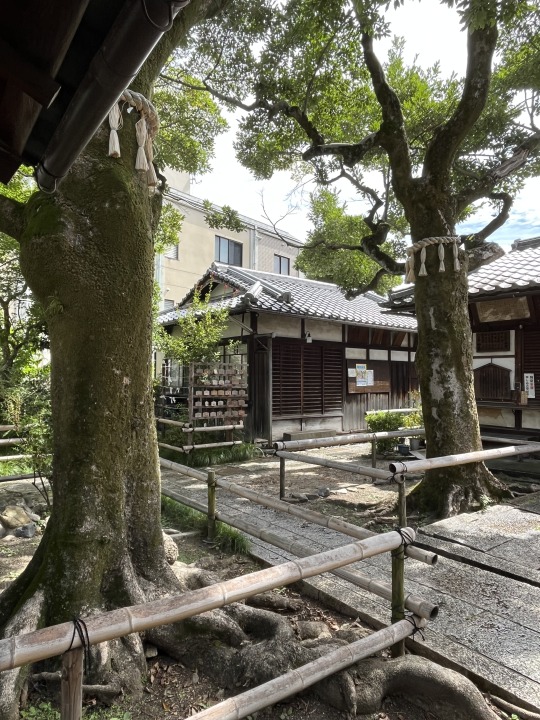
Photos are Mine, do not use without asking first
Excerpt from The Litany of the Tree
Trees teach us about growth
They also stand for shelter
They are, like water, living organisms
Ponder the meaning of growth and development
Think of how we know nature through our senses, our eyes, our taste, our sense of smell and touch, our awareness and deep intuitions
Let us think of the self-disclosure of the divine in the providence and power of nature
Let us think of the trees as expressions of beauty, power, and energy united in endless renewal...
Think of trees teaching us the steadiness of growth and of the time required for greatness to develop
Ponder why weeds grow faster than flowers, and why bushes grow faster than trees
Weeds wither in the heat of the sun
Trees grow and give shade
Trees are forms of the changeless yet ever-changing that can teach us the power of renewal
The divine within the cosmos and the divine within us...
3 notes
·
View notes
Text
Book 1 - START!

Here we gooOOOOO
Welcome to my liveblog of ガフールの勇者たち ! (gahuuru no yuushatachi -> Heroes of Ga'Hoole)
Remember a while back, when I bought the Japanese translation of the entire Guardians of Ga'Hoole series? I’m going to document my attempt to read through them with my elementary level grasp of the language. It’s going to be one part nostalgic re-read (not at all spoiler-free, sorry!) and one part language-learning crash course. I’ll try to organize my thoughts on the latter aspect in a way that non-speakers might still find interesting.
For instance, notice that Book 1, originally titled The Capture, has been renamed 悪の要塞からの脱出 (aku no yousai kara no dasshutsu -> Escape from the Evil Fortress). I know what you're thinking, and yes, from what I've seen, everything is going to look and sound way more badass compared to the original.
This is gonna be a long, slow, probably painful process, but by Glaux we're DOING this.

Note in the example above (from the first page of chapter 1) how the green-highlighted phrase 落ち着かない (ochitsukanai -> restless), which looks pretty complicated to me, does not have any smaller furigana characters to its right showing how it's actually pronounced. Kids at the book's reading level presumably already know, but I had to write the characters into a translator app to find out.
On the other hand, the character I highlighted in purple is 卵 (tamago -> egg), literally one of the first kanji that Duolingo taught me in its earliest lessons. But here it DOES have furigana (the tiny たまご to the right), so I guess Japanese children don't officially learn that character in school until a slightly higher grade level! Man, language is wild.
Anyway, back to reading the actual content of the book.
The first page of the book, before even the table of contents, is labeled ガフールの伝説 (gahuuru no densetsu -> The Legend of Ga'Hoole) and summarizes what Ga'Hoole fans would recognize as the classic “Coming of Hoole” tale. In addition to making me extremely emotional, it also drops several juicy proper nouns we’ll be seeing again later, including 最果ての地 (saihate no chi -> The Farthest Land) for Beyond the Beyond, 火の石 (hi no ishi -> the Fire Stone) for the Ember of Hoole, and ガフールの神木 (gahuuru no shinboku -> Sacred Tree of Ga'Hoole) for the Great Tree.
Guys we're not even on chapter 1 yet and there is SO MUCH happening. It is going to take me forever and a day to get through this. I'd better get started......
第一章 (daiisshou -> Chapter One)
ティトの森の家 (tito no mori no ya -> The Home in Tyto Forest)
So that’s, uh, interesting. Turns out Tyto is pronounced “tee-toh” in Japanese. That’s never not going to be weird. BUT, we must soldier on!
...Okay so, I think at least to start, the best way for me to do this is to go page-by-page. I’ll give my miscellaneous thoughts as I go, but then at the end of each page I’ll give a summary of what actually happens, to test my reading comprehension. (...This is going to turn into a straight-up school homework assignment dhgdjshfj.) In time, maybe I'll pick up enough speed to go through a few pages at a time, or even a whole chapter? But we'll see. That's far in the future right now.
Without further ado...
6ページ (the table of contents etc are all numbered pages, so chapter 1 technically starts on page 6) :
I’m excited every time I recognize a word, but I’m also hype to learn all the new animal/nature-related vocab in these books. I already knew “owl” was フクロウ (fukurou), but now I also know that Barn Owls in particular are called メンフクロウ (menfukurou), which thanks to my unquenchable etymology thirst I then found out comes from 仮面 (kamen -> mask). Fair enough, as many of the species in the Tytonidae family are called Masked Owls in English, too!
Also, fir trees are モミの木 (momi no ki)! I have nothing else to add about that, I just think it sounds nice. :) Momi.
(Fun fact for fellow non/early-Japanese-speakers: it’s customary for the names of most plants and animals to be written in the simpler, phonetic katakana alphabet instead of kanji, especially in a scientific context. So something like the word “monkey” (saru) would almost always be written as サル even though there IS a kanji spelling of the same word: 猿 This certainly makes it easier on people like me struggling to learn enough kanji as it is!)
...BOY HOWDY, I’m trying to read aloud as I go because I need to get the pronunciation in my head as well as recognizing the characters, and the phrase 胸の綿羽 (むねのめんう -> mune no men’u -> chest feathers) is kind of a tongue twister!
Anyway, onto the summary.
六ページの要旨 (Page 6 Summary) Soren (ソレン Soren) is a young Barn Owl who lives in a fir tree in Tyto Forest, and he’s about to become a big brother. His parents, Marella (マレラ Marera) and Noctus (ノクタス Nokutasu) fret over the state of the nest until suddenly a crack appears on the egg! Soren’s older brother Kludd (クラッド Kuraddo) grumbles, “Again?” Noctus scolds him--doesn’t Kludd want another little brother? Marella interrupts that it could be a sister.
Let’s do one more page for today, since this project is so VERY overdue!
...
7ページ
First thing of note is that Soren uses ぼく (boku) as his personal pronoun! In Japanese, there aren’t really third-person pronouns as we think of them in English, so other people are either referred to by name/title or you’re simply meant to figure it out from context. First-person pronouns (like English’s “I” and “me”), on the other hand, are not only used but are numerous and varied. Which word a person uses to refer to themself can vary based on gender, formality, and even just personality/preference! This excellent article on Legends of Localization gives a more detailed explanation, for anyone curious! I personally find this quirk of the language super fascinating and will be going out of my way to take note of how all the characters refer to themselves. :3 I expect most of them will be the common watashi or boku, but I’ll be interested to see if I’m proven wrong!
... And, unsurprisingly, we immediately learn that Kludd uses おれ (ore) for his personal pronoun. It’s another common masculine option, but, unlike boku, it often comes with more of a tough/strong/harsh connotation, and is thus on the more informal/crude side.
...
Fascinating. It’s never been totally clear to me if “branching” is really a proper word even in English to describe this thing where fledging birds practice flight by hopping from branch to branch, but when I put 枝渡 (edawatari) into the translator, it literally gives back “branching”. In the exact same sense, as far as I can tell.
...Hm! “Flight feathers” is 風切羽 (kazakiribane), which is literally written as “wind-cutting feathers”. Badass.
...One of the things that I think is going to be hardest for me to wrap my head around with this language is the regular use of onomatopoeia as just, like, whatever part of speech they wanna be. Sometimes they’re used as adjectives, like on the previous page when Marella described her husband’s “fluffy” (ふわふわ fuwafuwa) feathers, and sometimes they’re verbs, like this page’s description of the egg “rattling” (かたかた katakata). And sometimes they’re just literal descriptions of a sound like how we typically use onomatopoeia in English. This page describes a sudden “click” (カチッ kachi-) sound, for instance.
七ページの要旨 (Page 7 Summary) Soren pipes up that he’d like a little sister. Kludd jeers that Soren’s too young to even know what the word means, then complains that whether it’s a brother or sister, he’s missing out on branching practice. Noctus scolds him again, saying there’ll be plenty of time for practice later, and that it’ll be another month before Kludd’s flight feathers are grown in anyway. A noise from the egg grabs the whole family’s attention, because Barn Owls have very sensitive ears, and Marella joyfully cries out that the time has finally come. The egg rattles and shakes...
And that’ll be it for this post. My HOPE is that this process will get faster and shorter with each page. At the very least, this first few pages should be among the most densely packed with brand-new characters and noteworthy vocab to discuss.
Not sure how often I’m going to be updating this liveblog, but for now let’s shoot for a bare minimum of one page a week? Cool? Cool.
1 note
·
View note
Text
Eliot's Cat
When your heart's like shinboku,Should I become a shimenawa, Tied to you as if by divine construct,Like Time tied to Eternity? When unknown waves of passion subside,And the moon doesn't enchant anymore,Hokusai retires himself from ukiyo-e, and Mandelbrot decides to dive into the sea.The little fractals of Existence shine out,Life's quiddities rendered in faltering depths.I am Eliot's cat. I…
0 notes
Text
Ouma Great War Chronicles - Episode 12: Grateful Beyond Words
Narrator: As the research regarding the Soul-Resting Flute was not progressing as intended, Kaida, resenting Nagao and Genzuki’s laidback attitudes, unleashed some harsh words.
Kaida: At this rate, with the development of the Soul-Resting Flute at a standstill, not finding a countermeasure to the Treasure Chests of Lunacy is the biggest problem of all. We can’t deny the possibility that while we’re fending off maddened demons, the empire could turn into a total mess. That’s why… we should be rushing more. How can you two take such a laidback attitude when things are like this?
Nagao: Laidback attitude, you say… That’s not how I meant it though.
Genzuki: Mn… I also don’t think we should just take it easy. But, Haru-kun, I don’t thing rushing will be the solution to the research you’re doing –
Kaida: That’s exactly what I’m calling laidback. Sorry, but I don’t believe that you two are taking this issue as seriously as I am.
Genzuki + Nagao: …
Kaida: … Sorry. I’ll be going now.
Nagao: Ah, oi, Haru!
sfx: footsteps; door closes
Nagao: … and he’s gone. That really is quite the rush, isn’t it.
Genzuki: It might be our first time seeing Haru-kun like that. Is he okay?
Nagao: It is worrying, but for now, it would be no good to rub him the wrong way. In the meantime, let’s keep doing what we’re doing, and look for information that could be useful to Haru-kun’s research.
Genzuki: You’re right.
scene change: Bureau Research Department
Kaida: Hah… Ahh, geez! (I totally went too far with what I said… That was simply in the heat of the moment. It’s true that I felt a difference in the sense of pressure between myself and those two, but… It’s not like I ever thought they were not taking the case seriously.) (I have to apologize later… Though before that, I’d like to at least make a record of the research progress…)
sfx: footsteps; door opening
Hinata: Kaida-senpai!
Kaida: Uwah!? That surprised me… What is it, Hinata?
Hinata: Ah, pardon me! I couldn’t hold back my excitement. I finally found it! Information that seems helpful for developing the Soul-Resting Flute!
Kaida: Eh – For real!?
Hinata: Yes! Please take a look at this document. The Treasure Chest of Lunacy is a troublesome device that produces a special sound, which drives demons into a maddened state, right?
Kaida: Right. That’s why we’re working on developing the Soul-Resting Flute to create and opposing effect against the treasure chests.
Hinata: Yes. Something producing a calming sound that weakens demons… That’s the Soul-Resting Flute. However, the sound of the flute alone is not very effective, and no matter how many prototypes we made, none could be put to practical use. So, as a result of fishing through all kinds of literature, I found a Material that has a strongly sedating effect on demons. If the original flute is made with this, surely…
Kaida: We should be able to create the Soul-Resting Flute we envisioned! So, the material is?
Hinata: It’s this!
sfx: clatter
Kaida: This is…! I see, wood cut from part of a shinboku.* That was a complete blind spot. It’s true, this might be effective at suppressing demons’ powers. Alright. Let’s lay it out again with the material from the shinboku, and try making a prototype one more time!
Hinata: Yes sir! I’ll get everything prepared right away.
Kaida: Thank you. Bringing in compelling information like this, you’ve really saved the day. I’m glad I made you my assistant.
Hinata: … uk… Kaida-senpai… That makes me very happy, thank you!
Narrator: And thus, with the information brought forth by Tsubaki, development of the Soul-Resting Flute started to advace once more.
scene change: Nagao’s Workroom
Narrator: A few days later ─
Kaida: Um… A little while ago, I said something pretty cruel. I’m sorry. My research had stalled, and I had no composure left… But, I never actually believed that you two weren’t taking the case seriously.
Nagao: That kind of thing, we know already. More importantly, isn’t it great that the research is progressing!
Genzuki: Mn. Of course it’s good to have progress on this case, but… It’s a relief to see that Haru-kun’s complexion has improved.
Kaida: You both… (These two are always accepting of me like this. For that, I am grateful beyond words… I feel it so deeply, it must be ingrained in my body.) Mn, thank you.
Nagao: So going forward, are you focusing on developing that Soul-Resting Flute?
Kaida: Mn. But there’s also one more thing I want to try.
Genzuki: Something you want to try?
Kaida: You know how Genzuki receives talismans from the gods? I was wondering if they could be recreated synthetically.
Nagao: Man-made talismans…!?
Kaida: Mn. This way, even a person without Nagao’s battle insight would be able to use it in times of battle against demons.
Nagao: Oh man, Haru’s thinking up something crazy.
Genzuki: Aah. Before, you asked me to lend you a talisman. Could it be you were using it for this research?
Kaida: Yes, that’s right. I’d been doing only analyses before, but since a case like this one has come about, I think it would be better to properly recreate it after all. To make that happen, me working alone may not be enough. I’ll have to borrow some power from that kid again…
Narrator: The following day. Kaida requested of Tsubaki if he could possibly lend a hand in developing synthetic talismans.
Kaida: We’re still in the middle of developing the Soul-Resting Flute, but… can I make this ask?
Hinata: I see. Synthetic talismans…
==========
Translation notes
* A shinboku is a sacred tree or forest in the Shinto religion, usually found near shrines. Remember the sacred braided ropes, shimenawa, from an earlier episode? These sacred trees are decorated with them.
#ouma great war chronicles#vδlz#kaida haru#nagao kei#genzuki tojiro#nijisanji#english translation#ouma taisen tan
0 notes
Text
She has given various creatures asylum and care to the point where lost count how many she nurtured back to health ⏤ years spent salvaging what the world lost in the wake of a schism formed by all those who try to claim a piece of the dwindling fabric that is this planet. However the quest for such a prize made everyone all the more poorer. That she knows, and that she has seen already and now.
However, it's apparent that nothing is truly lost, but more so, it can be found and regained ⏤ like a prevailingshoot emerging beneath thawed soil. Roxanne witnesses the goddess rise to her feet again ( full splendor, mane billowing like tongues of flame ) ⏤ she is too much like the sun. The thought is further exemplified by a carpet of flora rolling out and radiating around them. All blades of grass and wild blooms lean toward them, a gesture of thanks.
Roxanne remains knelt before the she-wolf, who appeared much larger than what she initially perceived. She can feel the other's muzzle hover over her head, blowing a gentle, hair-tousling, warm gust. Comets tend to fade out once graced by the Sun's presence as though shying away, unable to turn its eyes toward starlight ( unworthy ) and vanish under its brilliant gaze.
But here, Roxanne is none the wiser and she smiles, slowly standing up to meet Amaterasu's glittering eyes.
❝No need for thanks, girl,❞ pet name said in jest, her hands find their way through the top of voluminous mane to underside of jaw, ❝Not yet, anyway. Something tells me there's still work to be done.❞
Her head swivels north-eastward, there is a reason why there was a spike in demonic attacks and it is no coincidence that a shinboku tree was nearby. The Eastern branch supposed that something may have happened to the sacred tree to render these grounds vulnerable to malevolent forces. Fortunately, the first set of challenges have been overcome and a new ally gained, with that she feels more confident in preventing some sort of onslaught, or at the very least staunch the bleeding with those who fight alongside her.
❝Say, you don't mind leading me to where I need to go?❞

As Roxanne approaches, Amaterasu pauses from her healing, worn-out gaze just barely able to hold the little one's. A prick of guilt emerges, she wished for her not to apologize for her sake, something told her that she is more than what meets the eye. Though words of comfort had to be saved until later, all that comes out from her mouth are raspy pants.
Without any time wasted, strings of bare sinew pulse the similar golden light the aid had, fibrous strings bursting to life and sewing where the fabric had been torn. Flora blooms where there had once been scalding blood, overtaken by vivid greenery. The strength that once had been lost is quickly returning back, illume sparking within her healing soul. It is like a forest experiencing succession through the viewpoint of a time-lapse. Such a spike in healing is sparse that is eroding by the river of time, but there's no time to worry on the what-ifs.
Grave is no longer here.
After a beat or two, the elden beast rose from her feet, at last; starlit fur devoid of the blood that appeared as rotten clumps. At her full height, She truly is something to be behold with her solar flared mane and the swirling markings that are embedded in her coat, inspecting herself to see if all is well.
To her relief, all exposed iron had faded.
She was so caught up in her troubles that introductions were second thought, she needed to repay the godling's generosity. But first, Amaterasu now laid eyes on her, and leaned to Roxanne's direction, without fear.
"Hrrrrfffff . . . " Like a horse, the warm breath exhaling her nose had mussied up the lady's bangs, coming out in rasps without exhaustion.

13 notes
·
View notes
Photo

Legends and myths about trees
Shinboku (lit. tree of God) – Sacred trees where gods dwell in Japanese prehistoric Shintoism
A sacred tree (shinboku) is a tree or forest worshipped as a shintai - a physical object of worship at or near a Shinto shrine, worshipped as a repository in which spirits and deities reside, or where they descend. They are often distinctly visible due to the shimenawa (lit. 'enclosing rope') wrapped around them. Types of sacred trees include evergreen cedar, pine and cleyera japonica (sakaki) that is regarded as a representative sacred tree and is often used in Shinto rituals.
In ancient Shinto, the Himorogi (lit. "divine fence") was considered to be a place where the gods dwelled, or a boundary between the everlasting world and the present world, and was feared and respected. In order to prevent people, things in this world, gods in this world, and things that bring misfortune and evil to this world from easily coming and going, shimenawa were hung as walls, making it a forbidden place.
Generally, the term refers to trees that are regarded as divine or sacred, as well as the guardian forests that surround them and that are not supposed to be cut down.

木にまつわる伝説・神話
神木 (しんぼく) 〜 日本の古神道における神の宿る樹木
神木 (しんぼく)とは、神社や祭壇の近くに祀られている木や森のことで、霊や神さまが宿る場所、神さまが降臨する所とされていた。注連縄が巻かれているため、はっきりと見えることが多い。神木の種類としては、常緑樹の杉や松、榊 (さかき) などがある。 この中でも榊は代表的な神木とされ、神事にも多く使われている。
古神道において神籬 (ひもろぎ) は、神の宿る場所としての神域、または常世 (とこよ) と現世 (うつしよ) の境界考えられ、恐れ敬った。また、現世の人々やもの、常世に存在する神々や現世に災いや不幸をもたらすものが、容易に出入りできないように、結界として注連縄をはり、禁足地とした。
一般的に、神体としての木や神聖視される木、その周りを囲む鎮守の森や、伐採をしないとされる木を指す。
#trees#tree legend#tree myth#legend#mythology#shintoism#shinboku#sacred trees#tree of god#philosophy#nature#art
163 notes
·
View notes
Photo

This fir tree in the Otte Shrine (追手神社) in Tamba-Sasayama, is 35.67 meters tall with a circumference of 7.68 meters. It is a giant fir tree in Japan and is said to be around 500 years old. In the local area, it is referred to as the "Sacred Shrine Forest" and called "Sennen momi", or the fir tree that is more than a thousand years old.
#Fall#Hyōgo Prefecture#Japan#Landscape#Otte Shrine#Tamba-Sasayama#autumn#fir tree#hiking#shinboku#丹波篠山市#兵庫県#神木#追手神社
72 notes
·
View notes
Text
Shinai naru Boku e Satsui wo Komete Ep. 1 (Sub. Esp)

DESCARGAR O VER ONLINE AQUÍ
#shinai naru boku e satsui wo komete#shinboku#jdrama#yamada ryosuke#kawaei rina#kadowaki mugi#onoe matsuya II#saotome taichi#takashima masahiro#sakurai yuki#sano shiro#endo kenichi#drama#dorama#proyectos activos#sub. español
4 notes
·
View notes
Text
ok so while i decide whehtwr to suck it up with subpar scans or buy digital books for mitarai house i am now reading the current work the ShinBoku duo are making now (and yes i just learned that that’s the official abbreviation for My Dearest Self….)
I’m on ch 13 of 37 and it also has a v strong murder mystery foundation 👍. also you can really tell its by the same author as shinboku based on the recurring themes between each work.
Like the focus on childhood trauma and abuse, and the subsequent cycle of abuse/trauma/hatred. The convo between the two bros where Sosuke wonders if anything would of played out differently if they knew the cause behind their father’s violent and abusive behavior is very similar to Eiji talking abt his step dad to Rei at end of shinboku…
I like these recurring themes actually because its a good glimpse into the mind and soul of the author. like these must be issues that weigh heavily on his mind. stuff like that.
idk what to read next like i really want to read the rest of mitarai’s house is burning down but like the raw scans of it i found are all lq and crusty….
well i say this despite having many options….
2 notes
·
View notes
Photo

Shinboku and Shimenawa (Ichinomiya, Chiba Prefecture, Japan)
1 note
·
View note